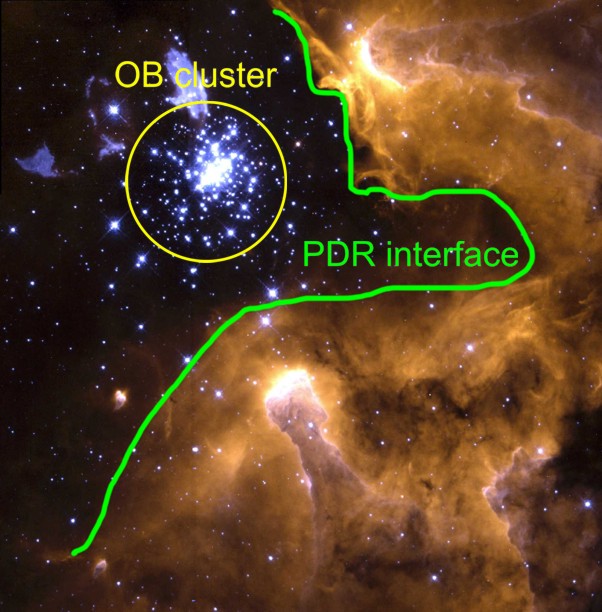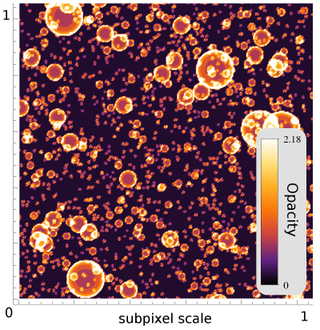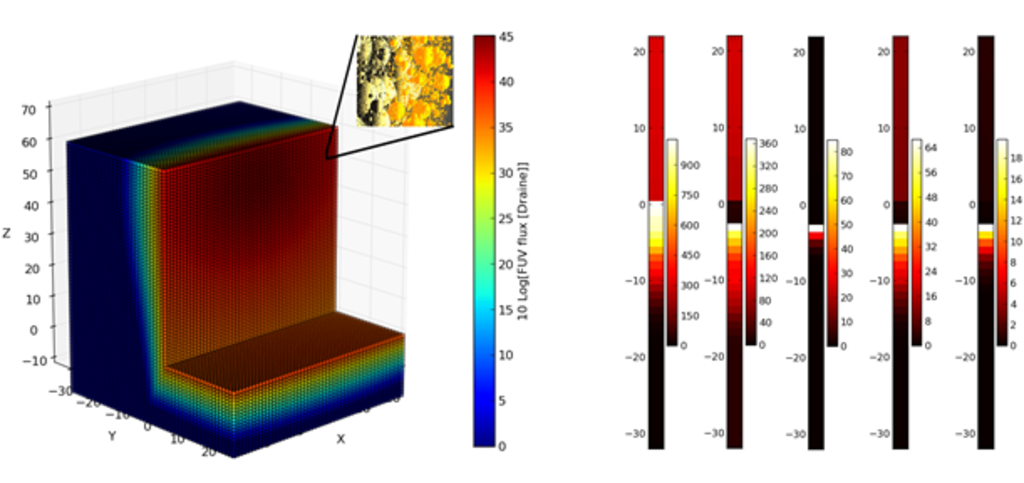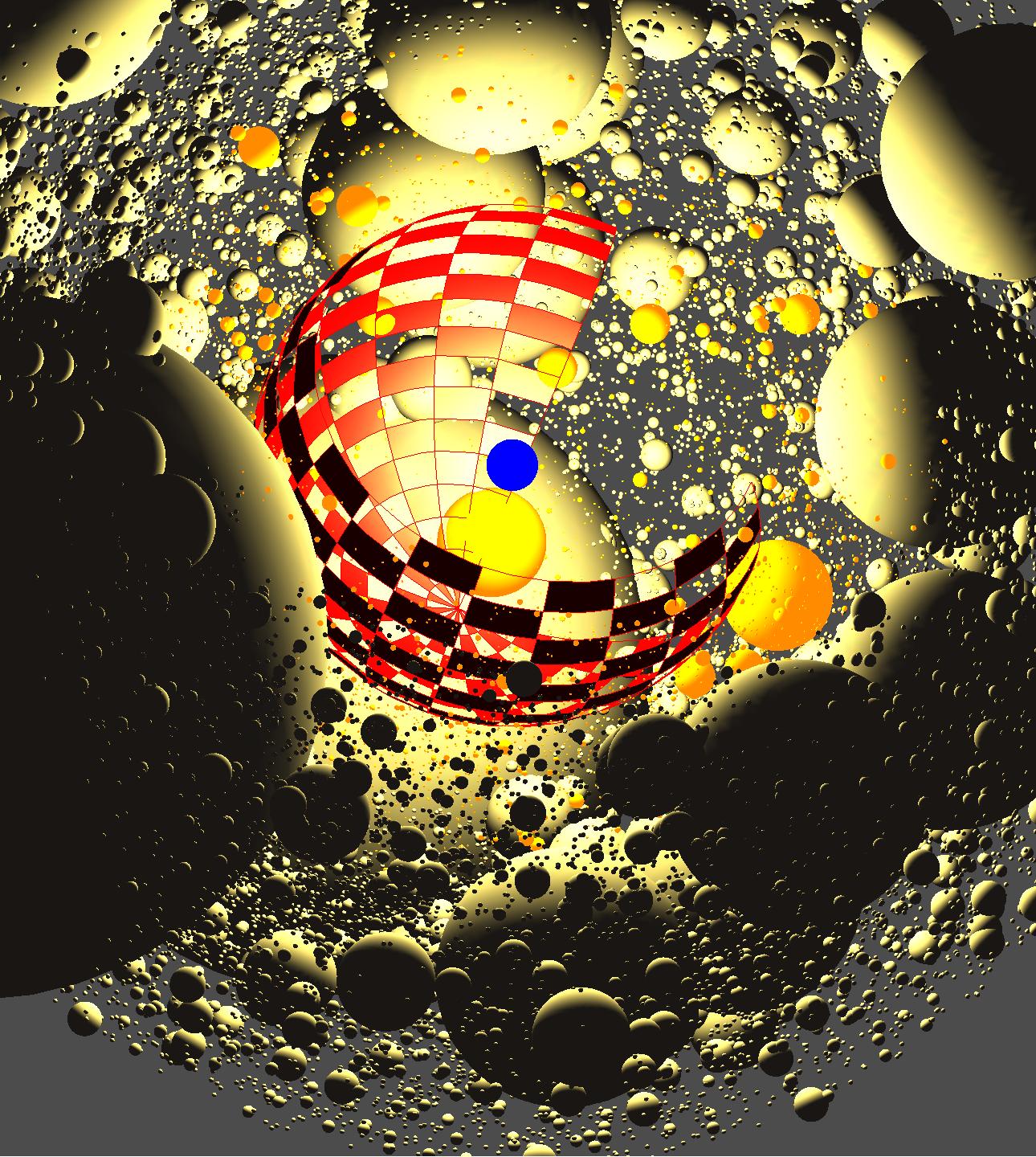Clumpy PDRs
Keywords: computational astrophysics, photon dominated regions, astrochemistry, physics of the interstellar medium, star formation feedback, radiative transfer, numerical simulation
Summary
Molecular cloud and star formation (SF) are the fundamental processes in the Cosmic Cycle of Matter. This cycle has shaped the evolution of the universe from the formation of the first generation of stars to its present appearance. The interaction of star formation with the interstellar medium (ISM) is most prominently marked by so-called photon dominated regions (PDR). My research goal is to contribute to a better understanding of the physics and the chemistry in PDRs. If we really want to understand planet and star formation we need to be able to reliably interpret the emission from PDRs. One of my main instruments of choice to achieve this goal is numerical modelling and I am the leading German expert on the numerical modelling of PDRs. Models are not just a tool to better understand your data. They can be a tool to better understand the physics of the universe. PDR Modelling in particular is crucial in interpreting observations of the interstellar medium (ISM) because all neutral atomic hydrogen gas and a large fraction of the molecular gas in the Milky Way external galaxies lie in PDRs.
Models of Photodissociation Regions (PDRs)
PDR modeling is my main focus. I am responsible for supporting and developing the KOSMA-τ PDR code and its applications. KOSMA-τ features a spherical geometry with isotropic FUV illumination and was part of the large PDR Comparison Benchmark (Röllig et al. 2007). The code is a further development of the plane-parallel PDR code from A. Sternberg, Tel Aviv, and has originally been built to study the C+ - C - CO stratification in PDRs. We constantly update the code and expand its capabilities. Present development projects include the inclusion of a much more refined dust treatment by coupling KOSMA-τ with a full dust radiative transfer code by R. Szczerba, Torun. This will provide the full continuum properties of the model clouds including observable SED’s given any dust composition. Additionally, we will also include the stochastic photo-heating of the very small grains (VSG’s), which is bealived to be an important contribution to the total energy balance of the cloud.
The spherical model geometry is perfectly suited to be applied in modeling clumpy ensembles of many individual clumps (Cubick et al. 2008).
 Figure left: This HST picture of NGC 3603 illustrates the typical PDR situation. The FUV radiation of the massive OB stars ionizes the surrounding ISM;and creates a HII region. On its way farther out, the FUV photons are absorbed and the FUV intensity decreases. Once the hydrogen recombination probability overcomes the ionization probability atomic and molecular material can exist. The transition from the ionized to the atomic/molecular region is called PDR interface or transition region. Credit: Wolfgang Brandner (JPL/IPAC), Eva K. Grebel (Univ. Washington), You-Hua Chu (Univ. Illinois Urbana-Champaign), and NASA
Figure left: This HST picture of NGC 3603 illustrates the typical PDR situation. The FUV radiation of the massive OB stars ionizes the surrounding ISM;and creates a HII region. On its way farther out, the FUV photons are absorbed and the FUV intensity decreases. Once the hydrogen recombination probability overcomes the ionization probability atomic and molecular material can exist. The transition from the ionized to the atomic/molecular region is called PDR interface or transition region. Credit: Wolfgang Brandner (JPL/IPAC), Eva K. Grebel (Univ. Washington), You-Hua Chu (Univ. Illinois Urbana-Champaign), and NASA
Clumpy PDRs
The current development of the KOSMA-τ PDR-model is coordinated through project C1 of the SFB 956. We simulate a clumpy medium by the principle of superposition, i.e. we compose the clumpy cloud from a variety of identical ‘building block’ according to certain distribution properties. Using full size distributions of clumps we can mimick the fractal structure of the molecular gas in star-forming regions.
 Figure left: [CII] optical depth distribution in a clumpy ensemble. The radiative transfer through the ensemble cannot be described by the average optical depth. Every cell in the 3D PDR model is composed of an ensemble similar to the shown one.
Figure left: [CII] optical depth distribution in a clumpy ensemble. The radiative transfer through the ensemble cannot be described by the average optical depth. Every cell in the 3D PDR model is composed of an ensemble similar to the shown one.
As test case we use the Orian Bar PDR to turn the above idea into a full model framework. The results are published in the PhD Thesis by Dr. Silke Andree-Labsch and in Andree-Labsch et al. (2016). (astro-ph)
As the KOSMA-τ PDR code only models individual spherical clumps, additional effort is needed to simulate the full complex structure of clumpy and filamentary molecular clouds in the vicinity of young stars. In previous approaches this was simply done by the superposition of an ensemble of clumps mimicking a fractal structure (Cubick et al. 2008). A proper treatment, however, has to take radiative transfer effects into account, in particular for the optically thick lines of CII and OI observed by Herschel and in future by SOFIA in configurations like the Orion Bar PDR. Existing plane-parallel PDR models always fail to explain the observed stratification of this region when fitting the line intensities. We implemented an extension of the KOSMA-t model by assembling a full three-dimensional model of the Orion Bar from an ensemble of clumps with an appropriate mass spectrum, immersed in a thin inter-clump medium, including the effects of FUV and FIR radiative transfer.
This model provides for the first time a self-consistent picture of the stratification structure of the Orion Bar PDR simultaneously fitting the line intensities and the relative spatial shifts of the emission profiles. The 3D clump-ensemble model (KOSMA-τ-3D) is defined in a flexible way so that it is planned to be applied to many more regions with more complex structures such as M17SW and whole starburst galaxies or the Milky Way.

2-Clumpy PDR Commponents in DR 21
 Herschel/HIFI observations provided the full range of far infrared (FIR) cooling lines in DR21. For DR 21 two ensembles with different properties have to be superimposed, a hot component, close to the inner HII region with strong FUV illumination, but only a small fraction of the total mass (orange clumps in the Figure), and a cooler component that provides the bulk of the material (beige clumps in Figure).
Herschel/HIFI observations provided the full range of far infrared (FIR) cooling lines in DR21. For DR 21 two ensembles with different properties have to be superimposed, a hot component, close to the inner HII region with strong FUV illumination, but only a small fraction of the total mass (orange clumps in the Figure), and a cooler component that provides the bulk of the material (beige clumps in Figure).
This two ensemble fit is able to reproduce all observed lines. We find no evidence for shock-heated material, in agreement with Lane et al. (1990). This seems to be in contradiction with the line profiles that show excited outflow material.
Figure: Examplary realisation of a two-ensemble model configuration. All dimensions are plotted true to scale. The position of the central OB cluster is indicated by a blue sphere. The edge of the surrounding HII region is shown by the red wireframe sphere. The hot component clumps are shown as orange spheres. They populate the inner shell. The cool component clumps are shown in beige populating the outer shell. All clumps are randomly positioned and assumedly embedded in a diffuse inter-clump gas.
Future Developments
The main work goes into the improved modelling of the microphysical and chemical processes in the KOSMA-tau PDR model. This means in particular accounting for non-stationary effects:
- to include the full time-dependent chemistry to the model. This will allow to model the impact of :
- ice evaporation
- advection flows
- progressing ionization fronts, and
- turbulent mixing
Markus Röllig and Yoko Okada are Co-Investigators of the ERS project “Radiative Feedback from Massive Stars as Traced by Multiband Imaging and Spectroscopic Mosaics”.
- As preparation for the launch of JWST, we are updating KOSMA-tau to solve the full H2 problem (full ro-vib structure). In addition we need to account for non-stationary PAH heating. This is work in progress.
- KOSMA-tau results will be made available on the PDR model database ISMDB of the Meudon group in order to allow a comparison between both models.
Project page in Cologne
Publications
2021 — Globules and pillars in Cygnus X. III. Herschel and upGREAT/SOFIA far-infrared spectroscopy of the globule IRAS 20319+3958 in Cygnus X
Schneider, N. ; Röllig, M. ; Polehampton, E. T. ; Comerón, F. ; Djupvik, A. A. ; Makai, Z. ; Buchbender, C. ; Simon, R. ; Bontemps, S. ; Güsten, R. ; White, G. ; Okada, Y. ; Parikka, A. ; Rothbart, N. , A & A 2021 Volume 653, id.A108, 22, DOI: 10.1051/0004-6361/202140824
2021 — Warm ISM in the Sgr A complex. II. The [C/N] abundance ratio traced by [CII] 158 μm and [NII] 205 μm observations toward the Arched Filaments at the Galactic center
García, P.; Abel, N.; Röllig, M.; Simon, R.; Stutzki, J. , A & A 2021 Volume 650, id.A86, 24, DOI: 10.1051/0004-6361/202039295
2018 — Anatomy of the massive star-forming region S106. The [OI] 63 micron line observed with GREAT/SOFIA as a versatile diagnostic tool for the evolution of massive stars
Schneider, N.; Röllig, M.; Simon, R.; Wiesemeyer, H.; Gusdorf, A.; Stutzki, J.; Güsten, R.; Bontemps, S.; Comerón, F.; Csengeri, T.; Adams, J. D.; Richter, H., Astronomy & Astrophysics, Volume 617, id.A45, 23 pp.
2012 — [CII] gas in IC 342
Röllig, M.; Simon, R.; Güsten, R.; Stutzki, J.; Hübers, H. W.; Hartogh, P.; Jacobs, K.; Guan, X.; Israel, F., Astronomy & Astrophysics, Volume 542, id.L22, 4 pp.
2011 — Photon dominated regions in NGC 3603. [CI] and mid-J CO line emission
Röllig, M.; Kramer, C.; Rajbahak, C.; Minamidani, T.; Sun, K.; Simon, R.; Ossenkopf, V.; Cubick, M.; Hitschfeld, M.; Aravena, M.; Bensch, F.; Bertoldi, F.; Bronfman, L.; Fujishita, M.; Fukui, Y.; Graf, U. U.; Honingh, N.; Ito, S.; Jakob, H.; Jacobs, K.; Klein, U.; Koo, B. -C.; May, J.; Miller, M.; Miyamoto, Y.; Mizuno, N.; Onishi, T.; Park, Y. -S.; Pineda, J.; Rabanus, D.; Sasago, H.; Schieder, R.; Stutzki, J.; Yamamoto, H.; Yonekura, Y., Astronomy and Astrophysics, Volume 525, id.A8, 12 pp.
2008 — The photon dominated region in the IC 348 molecular cloud
Sun, K.; Ossenkopf, V.; Kramer, C.; Mookerjea, B.; Röllig, M.; Cubick, M.; Stutzki, J., Astronomy and Astrophysics, Volume 489, Issue 1, 2008, pp.207-216
2008 — A clumpy-cloud photon-dominated regions model of the global far-infrared line emission of the Milky Way
Cubick, M.; Stutzki, J.; Ossenkopf, V.; Kramer, C.; Röllig, M., Astronomy and Astrophysics, Volume 488, Issue 2, 2008, pp.623-634
2008 — Submillimeter line emission from LMC N159W: a dense, clumpy PDR in a low metallicity environment
Pineda, J. L.; Mizuno, N.; Stutzki, J.; Cubick, M.; Aravena, M.; Bensch, F.; Bertoldi, F.; Bronfman, L.; Fujishita, K.; Graf, U. U.; Hitschfeld, M.; Honingh, N.; Jakob, H.; Jacobs, K.; Kawamura, A.; Klein, U.; Kramer, C.; May, J.; Miller, M.; Mizuno, Y.; Müller, P.; Onishi, T.; Ossenkopf, V.; Rabanus, D.; Röllig, M.; Rubio, M.; Sasago, H.; Schieder, R.; Simon, R.; Sun, K.; Volgenau, N.; Yamamoto, H.; Fukui, Y., Astronomy and Astrophysics, Volume 482, Issue 1, 2008, pp.197-208
2008 — Clumpy photon-dominated regions in Carina. I. [CI] and mid-J CO lines in two 4’x4’ fields
Kramer, C.; Cubick, M.; Röllig, M.; Sun, K.; Yonekura, Y.; Aravena, M.; Bensch, F.; Bertoldi, F.; Bronfman, L.; Fujishita, M.; Fukui, Y.; Graf, U. U.; Hitschfeld, M.; Honingh, N.; Ito, S.; Jakob, H.; Jacobs, K.; Klein, U.; Koo, B. -C.; May, J.; Miller, M.; Miyamoto, Y.; Mizuno, N.; Onishi, T.; Park, Y. -S.; Pineda, J. L.; Rabanus, D.; Sasago, H.; Schieder, R.; Simon, R.; Stutzki, J.; Volgenau, N.; Yamamoto, H., Astronomy and Astrophysics, Volume 477, Issue 2, January II 2008, pp.547-555
2007 — The interstellar medium of the Antennae galaxies
Schulz, A.; Henkel, C.; Muders, D.; Mao, R. Q.; Röllig, M.; Mauersberger, R., Astronomy and Astrophysics, Volume 466, Issue 2, May I 2007, pp.467-479
2006 — Study of photon dominated regions in Cepheus B
Mookerjea, B.; Kramer, C.; Röllig, M.; Masur, M., Astronomy and Astrophysics, Volume 456, Issue 1, September II 2006, pp.235-244

 Figure left: This HST picture of NGC 3603 illustrates the typical PDR situation. The FUV radiation of the massive OB stars ionizes the surrounding ISM;and creates a HII region. On its way farther out, the FUV photons are absorbed and the FUV intensity decreases. Once the hydrogen recombination probability overcomes the ionization probability atomic and molecular material can exist. The transition from the ionized to the atomic/molecular region is called PDR interface or transition region. Credit: Wolfgang Brandner (JPL/IPAC), Eva K. Grebel (Univ. Washington), You-Hua Chu (Univ. Illinois Urbana-Champaign), and NASA
Figure left: This HST picture of NGC 3603 illustrates the typical PDR situation. The FUV radiation of the massive OB stars ionizes the surrounding ISM;and creates a HII region. On its way farther out, the FUV photons are absorbed and the FUV intensity decreases. Once the hydrogen recombination probability overcomes the ionization probability atomic and molecular material can exist. The transition from the ionized to the atomic/molecular region is called PDR interface or transition region. Credit: Wolfgang Brandner (JPL/IPAC), Eva K. Grebel (Univ. Washington), You-Hua Chu (Univ. Illinois Urbana-Champaign), and NASA Figure left: [CII] optical depth distribution in a clumpy ensemble. The radiative transfer through the ensemble cannot be described by the average optical depth. Every cell in the 3D PDR model is composed of an ensemble similar to the shown one.
Figure left: [CII] optical depth distribution in a clumpy ensemble. The radiative transfer through the ensemble cannot be described by the average optical depth. Every cell in the 3D PDR model is composed of an ensemble similar to the shown one.
 Herschel/HIFI observations provided the full range of far infrared (FIR) cooling lines in DR21. For DR 21 two ensembles with different properties have to be superimposed, a hot component, close to the inner HII region with strong FUV illumination, but only a small fraction of the total mass (orange clumps in the Figure), and a cooler component that provides the bulk of the material (beige clumps in Figure).
Herschel/HIFI observations provided the full range of far infrared (FIR) cooling lines in DR21. For DR 21 two ensembles with different properties have to be superimposed, a hot component, close to the inner HII region with strong FUV illumination, but only a small fraction of the total mass (orange clumps in the Figure), and a cooler component that provides the bulk of the material (beige clumps in Figure).